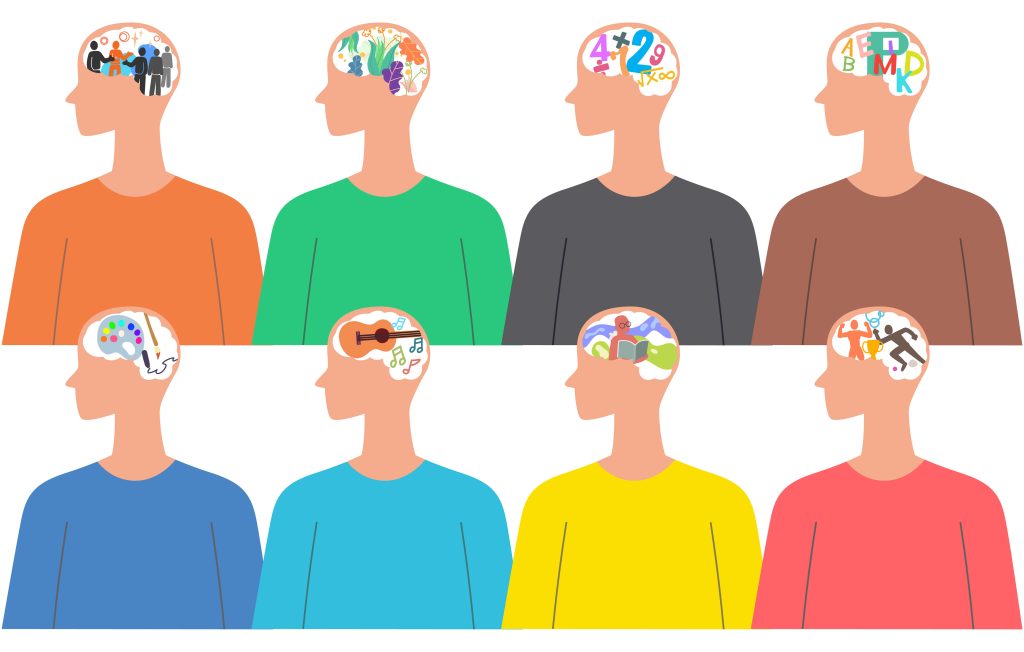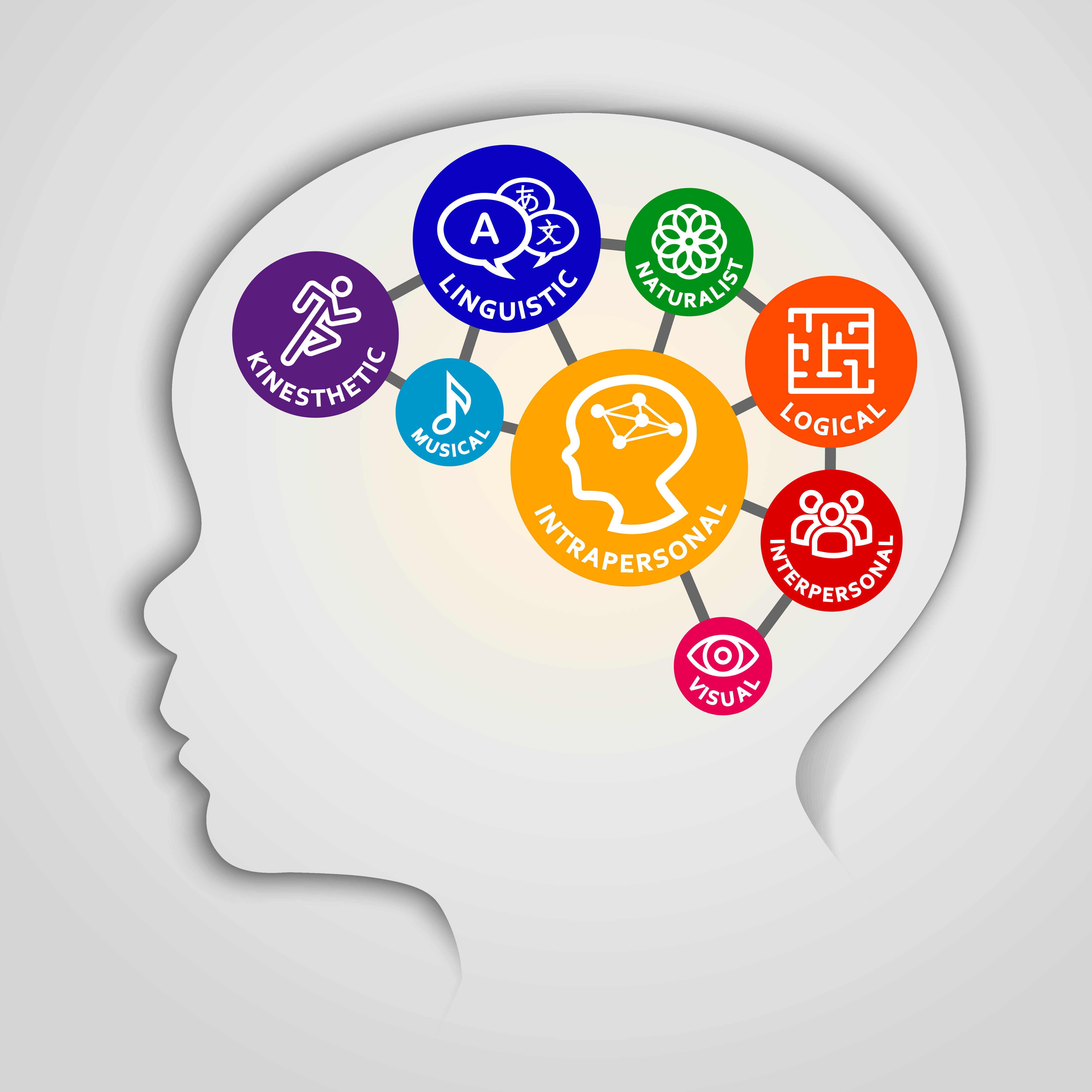Understanding Multiple Intelligences
A standardised IQ test has limitations, and Howard Gardner recognised this. He proposed a radical notion: intelligence isn’t a one-size-fits-all concept. Instead, it blossoms in varied forms, each as valuable as the next. These are the eight forms of intelligence labelled in the theory of multiple intelligences:- Linguistic Intelligence
- Logical-Mathematical Intelligence
- Spatial Intelligence
- Musical Intelligence
- Bodily-Kinesthetic Intelligence
- Interpersonal Intelligence
- Intrapersonal Intelligence
- Naturalist Intelligence

One Size Doesn't Fit All: The Need for Diverse Learning Approaches
The time has come and gone for a singular definition of intelligence to be the only yardstick. A student’s worth has historically been gauged by their proficiency in core subjects or their performance on standardised tests. This traditional assessment style, while simple, presented an incomplete picture.The Limitations of Traditional Intelligence Metrics
The classic perspective on intelligence, predominantly rooted in linguistic and logical-mathematical skills, overlooks a wealth of talents. A musical prodigy might struggle in geometry, a kinetic genius might find history texts cumbersome, and an interpersonal maestro might not recognise algebra if they passed it in broad daylight. When success and potential are determined by a narrow spectrum of skills, we ignore the diversity of brilliance that exists in the world.The Renaissance of the Multi-Intelligence Classroom
Gardner’s theory revolutionises teaching by describing the range of intelligences. From there, educators can tap into a reservoir of potential in every student. The classroom becomes a place where:- Personalised learning thrives.
- Confidence blooms.
- Engagement escalates.
The Eight Intelligences in Depth
Let’s dive deeper! Recognising these unique modalities of intelligence is the first step in a journey to understanding each intelligence and identifying them in our classrooms.Linguistic Intelligence
- Description
- In the classroom
Logical-Mathematical Intelligence
- Description
- In the classroom
Spatial Intelligence
- Description
- In the classroom
Musical Intelligence
- Description
- In the classroom
Bodily-Kinesthetic Intelligence
- Description
- In the classroom
Interpersonal Intelligence
- Description
- In the classroom
Intrapersonal Intelligence
- Description
- In the classroom
Naturalist Intelligence
- Description
- In the classroom
Strategies for Catering to Diverse Intelligences
Recognising and catering to diverse intelligences can be a game-changer for both educators and learners. Here, we'll present some practical strategies and classroom activities that are attuned to each of Gardner's intelligences.Linguistic Intelligence
- Strategy
- Activity Idea
Logical-Mathematical Intelligence
- Strategy
- Activity Idea
Spatial Intelligence
- Strategy
- Activity Idea
Musical Intelligence
- Strategy
- Activity Idea
Bodily-Kinesthetic Intelligence
- Strategy
- Activity Idea
Interpersonal Intelligence
- Strategy
- Activity Idea
Intrapersonal Intelligence
- Strategy
- Activity Idea
Naturalist Intelligence
- Strategy
- Activity Idea
Multiple Intelligences in Action
The power of theory lies in its application. Let's delve into a couple of potential scenarios where Gardner’s Multiple Intelligences theory could come into play, to give you an idea of what it could look like to bring his ideas to life.Engaging different intelligences
Picture a traditional primary school with standard teaching methods, facing challenges in engaging their diverse student body. In an effort to improve the situation, they initiate 'Multi-Intelligence Fridays', where students can pick activities based on their dominant intelligence. For instance, linguistic learners dabbled in storytelling, while spatial learners delved into art projects. Not only does student participation soar, but academic performance also improves. Teachers report enhanced class attentiveness and a noted increase in student collaboration.Something to suit everyone
An urban academy, in this case, is struggling with low student morale and dwindling enthusiasm for traditional learning methods. To address this, the school develops a comprehensive program integrating Gardner's eight intelligences into their weekly curriculum. For example, music (musical intelligence) is used to teach historical events, and nature outings (naturalist intelligence) are organised for science topics. As a result, the leadership team receives positive feedback. Test scores rise, attendance improves, and the school community has a newfound appreciation for diverse learning strengths. When a school acknowledges and nurtures the diverse strengths of its students, the results are more than just academic—it cultivates an environment where every student feels valued and equipped to shine.Digital Platforms Support Diverse Learning Styles
In an age where technology is woven into the fabric of education, it's great to see how digital platforms are rising to the occasion and ensuring that Gardner's vision for multiple intelligences enhances teaching.Interactive Learning Modules
Tailored for logical-mathematical learners, these modules allow students to engage with numerical and logical challenges, diving deep into problem-solving in an interactive environment.Virtual Reality (VR) and Augmented Reality (AR)
A haven for spatial learners, these technologies transport students to different realms, from historical sites to outer space, offering a visual and immersive learning experience.Podcasts and Audiobooks
Catering to linguistic learners, these tools make it possible for students to consume information auditorily, amplifying retention and understanding.Digital Music Creation Tools
For musical learners, these platforms offer a chance to compose, remix, and engage with music, all while learning the intricate nuances of sound and rhythm.Online Collaboration Platforms
Ideal for interpersonal learners, these tools allow students to engage in group projects, discussions, and collaborative brainstorming, irrespective of physical boundaries. Technology has huge potential to help teachers create bespoke learning for different intelligences. Integrating these platforms can contribute to ensuring that no student is left behind and every type of learner finds their place in the digital age.The Challenge of Assessment: Evaluating Beyond Traditional Metrics
Assessment is integral—knowing where someone is at is hugely helpful information to any educator. However, when we delve into the world of multiple intelligences, the picture offered by traditional assessment metrics is not necessarily the full image. A one-size-fits-all approach might not capture the diverse brilliance of the classroom.The Conundrum of Traditional Testing
For years, standardised testing has been the norm. It was designed predominantly for linguistic and logical-mathematical intelligence. While these tests are undoubtedly rigorous, do they genuinely encapsulate the creative genius of a spatial or bodily-kinesthetic learner? What are the alternatives? Assessment types for multiple intelligences:- Portfolio Assessments
- Performance-Based Assessments
- Peer Assessments and Group Projects
- Reflection Journals
Empowering Students: Fostering Self-awareness and Confidence
Education is empowerment. When students’ unique intelligences are recognised and celebrated, the classroom can nurture self-confidence and self-discovery.- The journey to self-awareness
- Voice and choice in learning
- Celebrating diverse achievements
- Peer learning and mutual respect
In Summary
Few theories have had such an impact on education as Howard Gardner’s Multiple Intelligences. A major departure from the one-size-fits-all approach, his work reminds us that the beauty of the human mind lies in its diversity of strengths and capabilities. Understanding this theory and putting it into practice can help educators to foster growth, success, and self-confidence in their learners. If you’re looking to learn more about this and other educational theories, strategies, practices, and more, take a look at our range of CPD courses for teachers.Further Reading & Resources
- Frames of Mind by Howard Gardner - the revolutionary work that introduced his Multiple Intelligences theory
- Multiple Intelligences: New Horizons in Theory and Practice - An updated, in-depth look at the Multiple Intelligences theory and how it can be used in practice.

